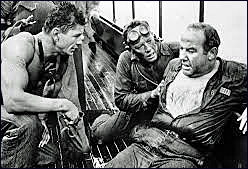Sun 23 Apr 2017
A Movie Review by Dan Stumpf: BIG HOUSE, U.S.A. (1955).
Posted by Steve under Crime Films , Reviews[6] Comments
BIG HOUSE, U.S.A. Bel-Air/United Artists, 1955. Ralph Meeker, Broderick Crawford, Lon Chaney Jr, William Talman, Felicia Farr, Reed Hadley and Charles Bronson. Written by John C. Higgins. Directed by Howard W. Koch.
Despite the title, this isn’t really a prison movie. It’s a film that could have been agreeably subversive, in the manner of Kiss Me Deadly, but instead it settles for being merely unpleasant.
Ralph Meeker stars as Jerry Barker, who seems at first to be just a guy out for a walk in the woods who stops to help a lost child. But this is Ralph at his nastiest, in a role that makes his Mike Hammer look like Saint Francis by comparison.

Things get disagreeable pretty quickly, and what seemed at first to be an act of kindness turns into extortion. Ralph almost comes out of those woods with $200,000 and a guilty secret. I won’t go into details, but it was all pretty grim, even for a seasoned old movie-watcher like me.
I said Ralph “almost†comes out of the woods with the money. Turns out he hid most of it back in the timber (at Royal Gorge National Park, where most of this was filmed) and when he’s picked up he only has a few thousand on him — enough to get nailed for extortion and draw a one-to-five-year sentence; with good behavior he can expect to get out in a few months and go back to claim his loot.
But things take an interesting turn when Ralph gets thrown in a cell full of cult-movie bad guys: Broderick Crawford, William Talman, Lon Chaney and Charles Bronson. And there’s another fun twist when Ralph’s cell-mates plan to bust out and take him with them… to lead them to his loot.
Like I say, this could have been enjoyably loathsome — like The Lineup or The Killers (the 1964 remake) with a writer and director attuned to its noir potential. But the folks in charge here decided to go for a Dragnet-style approach; Reed Hadley comes on as an FBI agent, complete with voice-over narration, and everything gets filmed at arm’s-length, in a near-documentary style, but without the sense of gritty realism.
Even the most harrowing moments — and there are quite a few here — are shot with a detachment that seems almost uncaring. And when everyone gets their comeuppance, we get no sense of things coming together or falling apart. All we get is the sad conviction that with this story hook and those actors, this could have been a lot better.